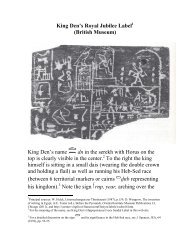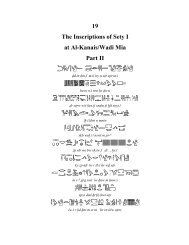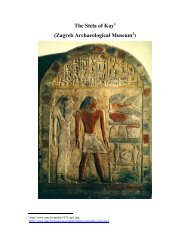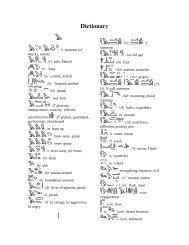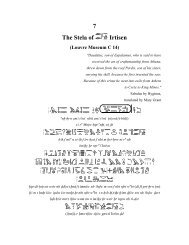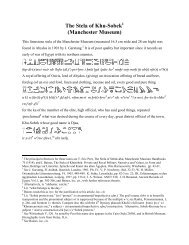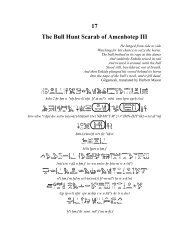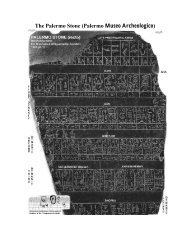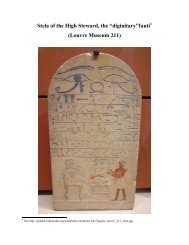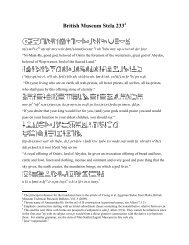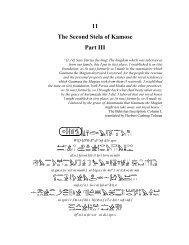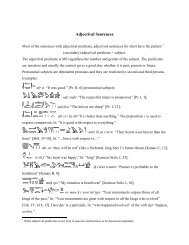Homework - Middle Egyptian Grammar through Literature
Homework - Middle Egyptian Grammar through Literature
Homework - Middle Egyptian Grammar through Literature
You also want an ePaper? Increase the reach of your titles
YUMPU automatically turns print PDFs into web optimized ePapers that Google loves.
<strong>Homework</strong> #1<br />
Indicate the order in which the signs should be read by numbering<br />
them next to the signs.
<strong>Homework</strong> #2<br />
Identify only the uniliteral signs and transliterate them:
<strong>Homework</strong> #3<br />
Use the uniliteral and biliteral charts to identify the uniliterals,<br />
biliterals, phonetic complements and the determinatives.<br />
Transliterate:<br />
side<br />
son<br />
see<br />
(ferry) across<br />
rejoice, be glad<br />
send<br />
daughter<br />
man-servant<br />
maid-servant<br />
, road, way,<br />
office, hall<br />
device<br />
construction, work,<br />
vizier<br />
donkey<br />
secret<br />
water<br />
crocodile<br />
mouth, utterance<br />
(noun) face<br />
(preposition) upon,<br />
concerning, because<br />
Notes: The determinative is not necessarily the last sign. There<br />
may be more than one determinatives for a single word. There is a<br />
subtle difference between the pintail duck and the goose, the<br />
former has a more pointed tail and tranliterates as zA and the latter<br />
as gb in gbb the Earth god. The latter occurs rarely.
<strong>Homework</strong> #4<br />
Transliterate and translate the following:<br />
(Vocabulary is attached at the end for your convenience.)<br />
1.<br />
2.<br />
3.<br />
4.<br />
5.<br />
6.<br />
7.<br />
8.<br />
son<br />
daughter<br />
man-servant<br />
maid-servant<br />
, road, way<br />
construction, work<br />
vizier<br />
donkey<br />
crocodile<br />
mouth, utterance<br />
(noun) face
<strong>Homework</strong> #5<br />
Transliterate and translate the following. The first 8 are noun<br />
phrases, the last 2 are sentences.<br />
1.<br />
2.<br />
3.<br />
4.<br />
5.<br />
6.<br />
7.<br />
8.<br />
9.<br />
10.<br />
Notes: Ignore the single stoke next to the pintail duck and<br />
focus on the seated man determinative. The determinative<br />
of town here carries a phonetic value nwt. For the sentences:<br />
In <strong>Egyptian</strong>, the predicate (verb) comes BEFORE the<br />
subject! Use the vocabulary of <strong>Homework</strong> 3. In the<br />
sentences the owl m is the preposition “in.” Finally, wjA is<br />
“bark, boat.”
<strong>Homework</strong> #6<br />
Transliterate and translate the following. The first 2 are noun phrases, the last 3 are<br />
sentences.<br />
1.<br />
2.<br />
3.<br />
4.<br />
5. (The god Amun-Re speaks to the pharaoh<br />
Thutmose III.)<br />
Notes: 3. The suffix pronoun attached to a verb is the subject, for example Dd.j<br />
means “I say.” n is the preposition “to.” 4. The <strong>Middle</strong> <strong>Egyptian</strong> word order is predicate<br />
(verb) + subject, for example Dd Hmt “the woman says.” 5. is the<br />
preposition “with.”<br />
jmj-r steward, overseer (manager)<br />
wr (adjective) great; (noun) elder<br />
xAst foreign land<br />
Dd say<br />
rn name<br />
Vocabulary<br />
zXAw scribe<br />
sxtj peasant<br />
Xnm empower<br />
haw body<br />
zA protection
Transliterate and translate the following:<br />
1.<br />
<strong>Homework</strong> #7<br />
2. What is the difference between the following? Explain the grammar.<br />
aA “great.” Hint: The cobra is the determinative for “goddess,” the scroll is for “thing.”<br />
3. The noun phrase<br />
is an example of a nfr Hr construction. bnr(j) “sweet,” mrwt “love.” Then try:<br />
4. Srj “little.”<br />
5.<br />
sxr “plan,” bjn “evil.”<br />
6.<br />
The old man leaning on a stick has several interpretations: jAw “old,” smsw “eldest,” wr<br />
“great, chief.” Choose the one that fits. Explain the twofold appearance of the suffix<br />
pronoun.
Transliterate and translate the following:<br />
<strong>Homework</strong> #8<br />
1. This is a construction involving comparison. Note the position of r:<br />
2. st “it” is an independent pronoun here, again a comparison:<br />
3. H(n)qt “beer” (note the suppressed n), dpt “taste,” bjt “honey” (the bee is an ideogram<br />
with phonetic value bjt). A comparison:<br />
4. jw mr.n.f “he loved,” a perfect verb construction. Tzm “dog, hound,” a comparison:<br />
(This is not a very nice thing to say!)<br />
5. An example of the superlative. Note the different roles of the seated man:<br />
6.<br />
zp “time.”<br />
7.<br />
wAt “side.”<br />
8.<br />
Note the irregular plural of king is nstyw.<br />
9.<br />
Xt “thing.”<br />
10.<br />
ky…ky “each other.” Try to guess the meaning of the first verb by its determinative.<br />
11.<br />
Remember the seated man admiring the stars is HH “million.”<br />
12.<br />
13.<br />
hrw “day.”<br />
14.<br />
dwAw “morning.” (The star is a triliteral with phonetic value dwA.)
Transliterate and translate the following:<br />
1. Note the dependent pronoun tw:<br />
Hna.j “with me.” Translate in future tense.<br />
2. Note the comparison:<br />
<strong>Homework</strong> #9<br />
aSA “many” (the plural strokes serve as a determinative!)<br />
3.<br />
4. note the exclamatory dual.<br />
5. mjtn “path.” Note the seated man at the end.<br />
6. twt “like,” n.s “to her,” st “it.”<br />
7. rwd “firm.”<br />
8. iw particle (not to be translated), sw “he,” m<br />
pA-Hrw “today,” sf “yesterday.” Note the comparative.<br />
9. m.k particle, can be translated as “look,” sDm<br />
“listen,” n “to,” r(m)T “people.”<br />
10. … jsT particle, can be translated as “now,”<br />
wrt very.
<strong>Homework</strong> #10<br />
Transliterate and translate the following as full sentences:<br />
1. Note the exclamatory dual of the adjective: , n.j “for me.”<br />
2. mdwt “talk, speech,” note the different roles<br />
of the seated man, translate pw as a demonstrative pronoun.<br />
3. jw particle (not to be<br />
translated) wn “exist, to be,” jm “there,” note the honorific transposition in the name,<br />
aSA “many” (the plural strokes serve here as a determinative!) n.f “for him.”<br />
4. Notice the nfr Hr construction (translate it as possessive).<br />
5. Translate js as “indeed”<br />
This is not a positive trait! (Hint: This sentence contains a nfr Hr construction listed in an<br />
earlier handout.)<br />
6. pwnt Punt probably present-day Somaliland:<br />
7. A pw nominal sentence.<br />
8. A pw nominal sentence, pA is a demonstrative pronoun here.
<strong>Homework</strong> #11<br />
Transliterate and translate the following as full sentences:<br />
1. dmj “harbor, abode,” jmnt (feather on a standard) = “west.” A<br />
pw B nominal sentence. This needs to be translated poetically.<br />
2. The throne here is ws (not the usual st) (see the list of biliterals for the<br />
two phonetic values), and with jr (the eye) these two are spelled together as wsjr “Osiris”<br />
(god of the Underworld).<br />
3. A pw nominal sentence! Notice that pw is placed forward<br />
between the noun and its modifying adjective.<br />
4. jrp “wine” and mw “water” (ideogram). Notice the<br />
preposition n with suffix pronoun. What is a good translation of the comparative wr…r..?<br />
In this sentence the owner is boasting about his wealth.<br />
5. wab “priest,” note the spelling of the sun-god. A<br />
pw nominal sentence! Note the forward position of pw within the indirect genitive.<br />
6. pxrt “remedy” (the intestine<br />
determinative from pXr “going around”), Haw “body,” mrHt “oil,” note the gender! A pw<br />
B nominal sentence.<br />
7. Transliterate and translate the following prepositional phrases:<br />
8. Translate as a full sentence (with future tense). aA<br />
“here.”<br />
9. sbH “cry,” wrt “very.” Translate as a phrase.
<strong>Homework</strong> #12<br />
Transliterate and translate the following as full sentences:<br />
1.<br />
jw particle, grt moreover, rdj.n.j I gave, Hqr hungry, jb<br />
thirsty, Hbs clothes, HAj naked. Tomb biography listing the owner’s good<br />
deeds.<br />
2. mj like.<br />
3. Twt you (Old <strong>Egyptian</strong> form of the 2S<br />
independent pronoun ntk/ntT).<br />
4. dbH.n.f he<br />
begged, dj.n.sn they gave, jrtt milk.<br />
5. xAst foreign land, Xr under, rd foot, note the plural<br />
and the dual!<br />
6. mH.n filled, m with, jtj barley.<br />
7. tAS boundary, jAbtj<br />
eastern, jtrw river, jmntj western.<br />
8. rSwt joy, mAA.sn<br />
they can see, mr pyramid.<br />
Transliterate and translate the following phrases:<br />
9. wAt path, wart flight.<br />
10. Htp peace, wrt very. Note the feminine endings.
<strong>Homework</strong> #13<br />
Transliterate and translate the following as full sentences:<br />
1. Sms follow, Hm majesty, rd<br />
foot (note the dual!), tj when.<br />
2. m.k look, HAb festival, translate the<br />
second particle as “now that.” (Sarcastic statement about adverse times.)<br />
3. hnw praise, r-pr temple.<br />
4.<br />
km complete, hrw days, jsT while, Abd month (refers to the monthly work-shift of ordinary<br />
people cleaning in the temple).<br />
5. sj she (dependent pronoun).<br />
6. nn (there was) no, wxA fool, Hr(j)-jb among<br />
(<strong>Egyptian</strong> idiom).<br />
7. translate n(j) as negation.<br />
8. wAD green, fresh, wAD-wr the Great Blue-Green = the sea,<br />
usually the Mediterranean or the Red Sea.<br />
9. xt tree, oA high.<br />
10. xA if only, nhj little, t bread.<br />
11. jm there.<br />
12. mnjw herdsman. Notice the m of predication.
<strong>Homework</strong> #14<br />
Transliterate and translate the following as full sentences:<br />
1. stj pour, jt(j)<br />
father (the horned viper is a determinative!), mwt mother, nHH eternity. Interpret this<br />
statement, e.g. what does the son do, and what does city of eternity means?<br />
2. dj make, nxt victorious.<br />
3. pr emerge, go up, m from, sbA<br />
teaching, sbA-pr house of teaching.<br />
4. jrj make, TAt vizier, rswt southern.<br />
5. remember the tongue is a reverse nisbe and<br />
should be transliterated as jmj-r !<br />
6. nn not (negation).<br />
7. jnj bring, wr<br />
(tribal) chief, Xrd child.<br />
8. a arm, n(j)<br />
negation, aHa stand, hAw vicinity. There is a nfr Hr construction in the sentence!
<strong>Homework</strong> 15<br />
Transliterate and translate the following:<br />
1.<br />
zbj = pass (subjunctive), nHH HH HH= HH eternity, ndm-jb jb =<br />
happiness (lit. sweet heart), Hz Hzt Hz<br />
= praise, jmj.k jmj.k = where you are (lit. you wherein), wnn wnn =<br />
exists(subjunctive), HHAtj<br />
H<br />
Atj = heart (organ), nnn<br />
n = negation, bt = abandon (the t ending is<br />
infinitive with suffix pronoun). The suffix pronoun refers to what? Why should the tomb<br />
owner worry about his heart?<br />
2. jw jw = wrong, crime, r = against (here). Who shouldn’t<br />
wrong here who?<br />
3.<br />
jr jrj jr jrj<br />
j = make<br />
(perfect), m m m3wt m3wt m3wt = anew, jnr jnr = stone, HD = white (also silver, shiny), rwdt wdt wdt = hard stone<br />
(usually sandstone), Ï3 = door, aS = cedar, m3(w) m3(w) = new, fresh, xt xtjw xt xtjw<br />
jw (with the tjw-bird!)<br />
=hillside (reference to Lebanenese cedar forests), m m HAt HAt = before (time). Description of a<br />
new temple.<br />
4.<br />
js jst js particle, r.f r.f particle (for emphasis), km km =<br />
complete(perfect), ar = ascend(perfect), Ht Htp Ht = rest, peace, jm = there, dt and nHH HH both<br />
mean eternity but one is in space the other in time; look at the determinatives! What does<br />
the suffix pronoun after jm jm jm refer to?<br />
Uses of the preposition jr jr: jr<br />
5. jr+adjective-verb = if…, HA HAtj HA<br />
tj tj = mayor<br />
Notice the r of futurity.<br />
6. jr jr+noun jr = as for…,dt-nswt nswt nswt =<br />
king of eternity. ntjw ntjw jm jm (note the plural nisbe) refers to whom? Notice the A pw nominal<br />
sentence after jr.<br />
7. jr jr +<br />
wnn wnn + subject = if+subject+is..., mdwt mdwt = speech, Xrt rt rt-Hr rt Hr Hrw Hr = daytime, ra = day. Advice to a<br />
subordinate.<br />
8. mjtt.s mjtt.s = the likes of it,<br />
dr = since, p3t p3t = old time, antiquity.



